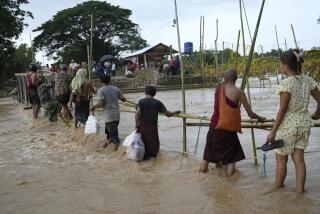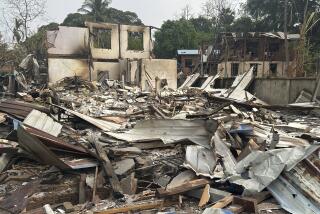News from disaster zone is scarce
- Share via
Nearly a week after a cyclone ravaged Myanmar, food, medicine and fresh drinking water are not the only necessities in short supply. So are independent news accounts from the isolated and politically repressive nation.
Expatriates and others have been forced to rely mostly on secondhand accounts and reports from correspondents based in neighboring nations for information about the disaster, which the government says has killed more than 22,000 people.
New-media operators and “citizen journalists,” touted as an alternative source of information in such cases, have provided few new details about the suffering in Myanmar.
Only a few mainstream media outlets, including the Los Angeles Times and New York Times, have succeeded in dispatching correspondents and producing firsthand accounts from a nation whose military leaders disdain scrutiny.
“I think that is the biggest failure or problem of the government of Myanmar at this point, failing to utilize the sympathy and understanding of the world,” said Ananda Guruge, a Rosemead-based Buddhist scholar. “That sympathy comes from information that is expressed through the press.”
Guruge recalled the quick and wide-ranging coverage of the Indian Ocean tsunami in 2004, which prompted an outpouring of aid from foreign governments and private groups. “Without that information, the infrastructure problems of Burma cannot be solved,” said Guruge, using the nation’s other name.
Editors at both the Los Angeles Times and New York Times said they scrambled to get reporters to the scene from the moment the cyclone struck last weekend.
They declined to identify their correspondents or describe how they made it into Myanmar roughly five days after 120-mph winds devastated the southern part of the country, for fear that the government would try to oust them.
By Thursday, both papers had reports on their websites offering details about the suffering around Yangon, the country’s largest city.
“There is no substitute for the correspondent on the ground,” said Peter Osnos, a former Washington Post foreign editor who is now a book publisher.
Previous disasters have proved to be opportunities for “open-source” reporting, in which citizens post photographs, videos and written accounts that help broaden the perspective on a crisis. But the Myanmar cyclone has produced a paucity of such Internet accounts.
Nowpublic.com, which advertises its “Crowd Powered Media” and claims posts from as many as 20,000 individuals a month, has featured little original reporting from Myanmar this week.
Its accounts draw largely from mainstream news organizations and dispatches written by expatriate Burmese, although the site did feature a photograph and short report from an Italian traveling in the country when the disaster hit.
Michael Tippett, co-founder of Vancouver, Canada-based Nowpublic, said reports from the field probably have been stymied by several factors, including the low Internet penetration in Myanmar, the collapse of utilities in the storm and the fear of posting information that might anger the military government.
The New York Times also added to its coverage with “crowd sourcing,” asking readers in Myanmar to contribute photos and written accounts, but those resulted in only a couple of Internet reports.
--
More to Read
Sign up for Essential California
The most important California stories and recommendations in your inbox every morning.
You may occasionally receive promotional content from the Los Angeles Times.











